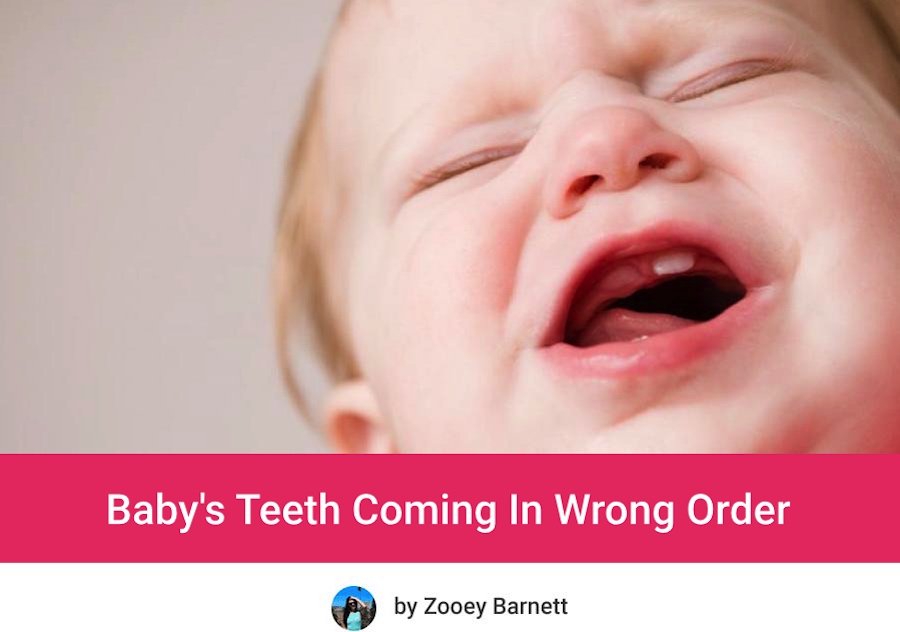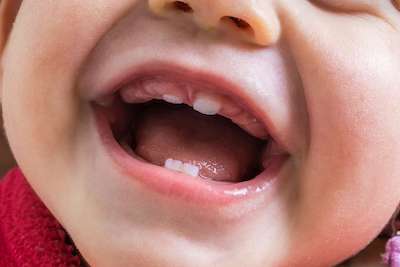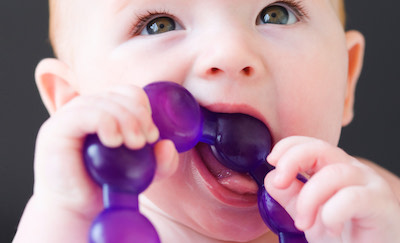
As parents, we just cannot wait for our babies to achieve their firsts; the first smile, the first grasp, the first tooth, the first word, the first step…
However, sometimes things might not go as planned (or described in books for parents). Teething is one of those things. For instance, you might be worried when your baby’s teeth are coming in the wrong order.
Since every baby is born differently, chances are that yours might not be following the exact order of tooth eruption, which is quite common, as the timeline for different teeth may overlap.
If your baby’s teeth don’t show up by the time they are 18 months old, the American Academy of Pediatrics recommends that you should take this up with your pediatrician.
This article is not a substitute for medical advice or consultation.
Order Of Tooth Eruptions & Timing
On average, by the time your child is three, they will have a set of 20 teeth, with 5 different types of teeth namely:
- Central incisors (the front teeth)
- Lateral incisors (between the central incisors and the canines)
- The first molars
- The canines (adjacent to the first molars)
- The second molars (the teeth at the back)
Since every baby is different, some babies’ teeth begin erupting by the 4th to 7th month, whereas for some babies it might be their 9th month, or sometimes, the baby teeth eruption may start after their first birthday.
Genetics also plays an important role. Babies get their teeth early if their parents had them early too. Some newborn babies might even be born with one or more teeth. Generally, most babies are expected to get their bottom front teeth initially, followed by the rest.
Keeping in mind the differences, here is a general timeline for baby tooth eruptions1:
- Lower central incisors (6-10 months)
- Upper central incisors (8-12 months)
- Upper lateral incisors (9-13 months)
- Lower lateral incisors (10-16 months)
- Upper first molars (13-19 months)
- Lower first molars (14-18 months)
- Upper canines (16-22 months)
- Lower canines (17-23 months)
- Lower second molars (23-31 months)
- Upper second molars (25-33 months)
Lower central incisors are the first teeth to come, around 4-7 months. After the bottom central incisors, the next teeth that erupt are the upper central incisors, followed by the upper lateral incisors and then the lower lateral incisors.
Their eruption is followed by the front molars, upper and lower respectively, and then the canines follow. In the end, lower and upper second molars erupt behind the front molars. As per research, most toddlers have around 20 teeth during the first three years.
There is no hard and fast schedule that your baby should get their teeth in the exact time frame.
The best way to keep an eye on your baby’s teeth development is to check for new teeth every four months once they start teething. For example, if they get their first teeth at 6 months, expect teething in the adjacent tooth group after four months.
Children’s teeth, also called deciduous teeth start falling around 6 years of age, which are then replaced by adult teeth or permanent teeth by 12-13 years2.
Your child will grow 3 more sets of molars, with the first two sets coming in between the ages of 6 to 12 years. Around 17-21 years, they get the third set of molars which is better known as the wisdom teeth.

Baby Teeth Coming In Wrong Order – How To Tell
Though it is best if the teeth erupt in the right order, it is perfectly normal if your baby’s teeth erupt differently.
What matters most is that there is enough space between the teeth to avoid gum disease. As you know, baby teeth are smaller as compared to permanent teeth, so generally there is a lot of space around the teeth. If you think if baby’s teeth are coming in rather close and overcrowded, talk to a pediatric dentist to get things sorted3.
You can tell your baby’s teeth are coming in the wrong order if they start teething altogether, or if they have molars coming in before the front teeth come, or if upper teeth come before lower teeth.
Here are some of the things to pay attention to:
- Teething signs
If your baby shows symptoms like a low-grade fever, drooling, gnawing, irritability, coughing for no reason, and chewing on things; this means they are probably teething.
- Overcrowded teeth
If there is less than normal space between your baby’s teeth, or if they appear quite close to each other, you should get them checked by their pediatric dentist. Overcrowded primary teeth can lead to alignment problems for permanent teeth.
- Tooth decay
When the teeth are crowded, baby’s teeth are prone to tooth decay and gum disease, since they are sensitive. If left unchecked, this can cause infections, early tooth loss, brown spots on teeth, feeding difficulties, cavities, and much more.
- Non-typical order of eruption
When you inspect your baby’s teeth using clean hands, you might notice deviation in the normal eruption of baby teeth. For instance, they might have first molars coming in while the bottom central incisors are a no-show.
- No teeth till 18 months
If your child’s baby teeth do not erupt till 18 months of age, you should get help from a pediatrician, who can better assess the situation, and might even involve the pediatric dentist.
Since it is normal to have a baby’s teeth erupting in the wrong order, you can maintain oral health and discuss this issue with the pediatrician.

Why Are My Baby’s Teeth Coming In The Wrong Order?
Here are some of the reasons which explain your baby’s teeth coming in wrong order:
Genetics
Genetics plays a major role in your baby’s teeth coming in the wrong order. If you or your partner had your milk teeth come in quickly back in the day, chances are that your baby will follow suit.
If you got all your baby teeth fairly quickly, your baby’s teeth will erupt altogether too. These tooth eruptions can lead to overcrowding, development problems, and tooth infections.
Some genetic conditions like Apert syndrome and Down’s syndrome may also cause baby teeth to erupt in wrong order.
Premature Birth
Usually, teething problems occur in babies born prematurely, often accompanied by low birth weight and feeding difficulties4.
Early Loss Of Tooth
If your baby has lost a tooth to decay, the adjacent teeth might shift, which causes permanent teeth to come crooked, and come out of place in the wrong order. It can also affect the growth of facial bones and jaw position.
Less Access To Medical Care
Many parents don’t know how important it is to see a dentist when it comes to wrong order of tooth eruptions. Early intervention can ensure proper alignment and prevent tooth decay (early tooth loss, infections, brown spots on teeth, etc.).
Does It Matter If Baby Teeth Come In The Wrong Order?
It is totally normal if your baby’s teeth grow in the wrong order because the general timelines of tooth eruptions coincide with each other. Your baby’s primary teeth will eventually make way for their adult teeth or permanent teeth.
It is important to see a dentist or your pediatrician to ensure healthy tooth growth as your child is at a higher risk of tooth loss and gum disease if their teeth are overcrowded due to erupting in the wrong order.

What You Can Do About Baby Teeth Coming In The Wrong Order?
First things first, you cannot reverse your child’s teeth coming in the wrong order. But here are a few things you can do to ensure your child’s dental health in the future:
- Talk to a pediatric dentist
You should take the issue up with your baby’s pediatric dentist, who will offer support and guidance to ensure proper development, alignment, and good oral health in the future.
Medical intervention is important because sometimes the wrong order of tooth eruption can block adult teeth eruption in the future. If the misaligned baby tooth has not fallen out yet, it might cause the permanent tooth to erupt anyway, but with a greater risk of cavities (due to difficulty in cleaning the misaligned teeth properly5).
- Maintain good dental health
It is recommended that you use a washcloth to clean your baby’s gums. Simply wrap a clean damp washcloth around your clean finger and swipe it across your baby’s gum line. As soon as a new tooth erupts, use a toothbrush (without toothpaste) to keep the baby’s teeth clean and healthy.
- Soothe teething signs
If you have older kids, you know baby teeth do not come easy, for both the baby and the parents. Babies are generally irritable, there is a lot of drooling and chewing, and sometimes it is even accompanied by a low-grade fever.
You can give them a clean washcloth (dipped in water and frozen for 15 minutes) for chewing, or offer frozen fruit, or a teether.

Final Verdict: Is It Normal For Baby Teeth To Come In Out Of Order?
Yes, it is totally normal if baby teeth grow and erupt out of order. Usually, the front teeth are the first to erupt, but even if your baby’s teeth do not follow the average timeline, it is usually not a reason for concern.
You should always check for new teeth every 4 months after your babies get their first teeth.
Also, if you notice crowding, or many teeth coming together at once, you can discuss this with your pediatric dentist to ensure proper alignment and development of your child’s teeth.
With good oral health and your doctor’s help, your baby’s dental health will be in good hands.
When Should You Be Worried & Talk To Pediatric Dentist?
Tooth decay is definitely a cause for concern and you should definitely discuss it with a pediatric dentist for timely intervention. It puts the baby’s teeth at increased risk of:
- Brown or yellow spots on teeth
- Infections
- Early tooth loss
- Cellulitis (an infection that spreads beneath the skin and gums)
- Cavities
- Swollen pink gums (Gingivitis/ Gum’s disease)
- Difficulty in feeding
- Poor self-confidence due to misaligned teeth
- Odd looking teeth
- Extra wide space between teeth (2mm space is normal)
Baby’s Tooth Development – FAQ
Now that we have covered everything you need to know about baby teeth coming in wrong order, here are a few more questions that you might have regarding your baby’s tooth development.

When Does Teething Begin?
Teething usually begins around 4-7 months. Most babies get their front teeth (the central incisors) first, followed by lateral incisors, the first molars, the canines, and lastly the second molars. Your child is going to have 20 pearly whites during the first three years.
Mostly, babies get their bottom teeth first, the bottom central incisors.
That being said, your child may cut their first tooth around the ninth month, or maybe even on their birthday. It is quite common if they do not follow the general pattern of tooth eruption.
If your baby is toothless by the age of 18 months, it is recommended by the AAP to visit a pediatrician or pediatric dentist6.
Can Baby Teeth Not Come In Pairs?
Mostly, baby teeth come in pairs. These alternate between top and bottom teeth. However, if your child’s teeth are not coming in pairs, it is not a cause for concern, as long as they are erupting.
For instance, it might take a lateral incisor longer to erupt than its counterpart.
Which Teeth Are Most Painful For Babies?
The molars are the most painful teeth for babies. Since they have a bigger and wider surface, they cause more discomfort as compared to other sets of teeth.
What Is Misalignment Of Teeth In Baby?
Misalignment (also known as malocclusion) is when a baby’s teeth are overcrowded or crooked, and they do not align properly, as in the upper teeth do not meet the lower teeth correctly.
It can be due to genetics, overcrowding, or early loss of baby teeth, which can lead to crooked and misaligned teeth. These can cause feeding difficulties, cavities, and impaired dental health, which could lead to serious implications for permanent teeth7.
One of the reasons for misalignment can be also prolonged use of bottle by toddler and frequent sucking on the bottle’s nipple, as well as pacifier.
It can be addressed by pediatric dental care and orthodontic interventions.
The purpose of this article is informative. It’s not a substitute for professional medical advice or medical care. Remember: safety first! Consult your doctor/pediatrician in case of any doubts. The author of this article does not accept any responsibility for any liability, loss or risk, personal or otherwise, incurred as a consequence, directly or indirectly, from any information or advice contained here.
Resources:
https://www.healthline.com/
https://www.mouthhealthy.org/
https://www.cdhp.org/
https://mom.com/
https://juniorsmilesofstafford.com/

